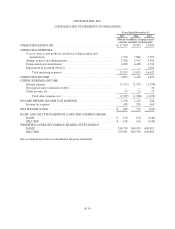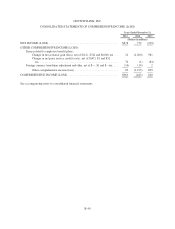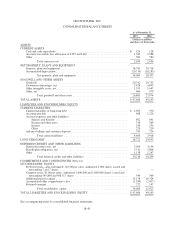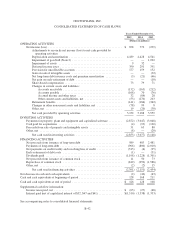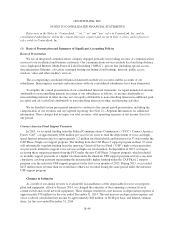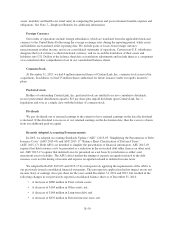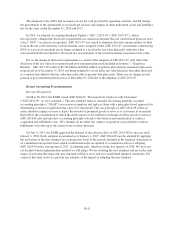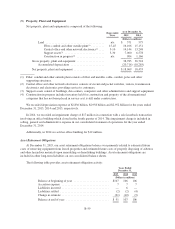CenturyLink 2015 Annual Report Download - page 157
Download and view the complete annual report
Please find page 157 of the 2015 CenturyLink annual report below. You can navigate through the pages in the report by either clicking on the pages listed below, or by using the keyword search tool below to find specific information within the annual report.straight-line methods, depending on the type of customer. We amortize capitalized software using the straight-
line method over estimated lives ranging up to 7 years, except for approximately $237 million of our capitalized
software costs, which represents costs to develop an integrated billing and customer care system which is
amortized using the straight-line method over a 20 year period. We amortize our other intangible assets
predominantly using the sum-of-the-years-digits method over an estimated life of 4 years. Other intangible assets
not arising from business combinations are initially recorded at cost. Where there are no legal, regulatory,
contractual or other factors that would reasonably limit the useful life of an intangible asset, we classify the
intangible asset as indefinite-lived and such intangible assets are not amortized.
Internally used software, whether purchased or developed by us, is capitalized and amortized using the
straight-line method over its estimated useful life. We have capitalized certain costs associated with software
such as costs of employees devoting time to the projects and external direct costs for materials and services.
Costs associated with software to be used for internal purposes are expensed until the point at which the project
has reached the development stage. Subsequent additions, modifications or upgrades to internal-use software are
capitalized only to the extent that they allow the software to perform a task it previously did not perform.
Software maintenance, data conversion and training costs are expensed in the period in which they are incurred.
We review the remaining economic lives of our capitalized software annually. Capitalized software is included in
other intangible assets, net, in our consolidated balance sheets.
Our long-lived intangible assets, other than goodwill, with indefinite lives are assessed for impairment
annually, or, under certain circumstances, more frequently, such as when events or changes in circumstances
indicate there may be an impairment. These assets are carried at the estimated fair value at the time of acquisition
and assets not acquired in acquisitions are recorded at historical cost. However, if their estimated fair value is less
than the carrying amount, other indefinite-lived intangible assets are reduced to their estimated fair value through
an impairment charge to our consolidated statements of operations.
We are required to assess goodwill for impairment at least annually, or more frequently, if an event occurs
or circumstances change that would indicate an impairment may have occurred. We are required to write-down
the value of goodwill in periods in which the recorded amount of goodwill exceeds the implied fair value of
goodwill. Our reporting units are not discrete legal entities with discrete financial statements. Therefore, the
equity carrying value and future cash flows must be estimated each time a goodwill impairment assessment is
performed on a reporting unit. As a result, our assets, liabilities and cash flows are assigned to reporting units
using reasonable and consistent allocation methodologies. Certain estimates, judgments and assumptions are
required to perform these assignments. We believe these estimates, judgments and assumptions to be reasonable,
but changes in many of these can significantly affect each reporting unit’s equity carrying value and future cash
flows utilized for our goodwill impairment assessment.
We are required to reassign goodwill to reporting units each time we reorganize our internal reporting
structure which causes a change in the composition of our reporting units. Goodwill is reassigned to the reporting
units using a relative fair value approach. We utilize the earnings before interest, taxes, depreciation and
amortization as our allocation methodology as it represents a reasonable proxy for the fair value of the operations
being reorganized.
See Note 2—Goodwill, Customer Relationships and Other Intangible Assets for additional information.
Pension and Post-Retirement Benefits
We recognize the funded status of our defined benefit and post-retirement plans as an asset or a liability on
our consolidated balance sheet. Each year’s actuarial gains or losses are a component of our other comprehensive
income (loss), which is then included in our accumulated other comprehensive loss. Pension and post-retirement
benefit expenses are recognized over the period in which the employee renders service and becomes eligible to
receive benefits. We make significant assumptions (including the discount rate, expected rate of return on plan
B-49


